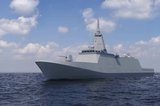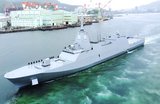Nordic firms team up on modular mine laying system
A rendering of a Cube system minelaying module. (Photo: SH Defence)
Denmark’s SH Defence and Finland’s DA-Group and Forcit Defence have signed a multi-party MoU to develop the use of The Cube system for launching, laying and storing sea mines.
The cooperation will use SH Defence’s The Cube system and explore the integration of mines, including the Blocker and Turso models.
The solution will be based on The Cube system's modular ISO frames and handling equipment and DA-Group’s Sumico naval modular minelaying concept.
DA-Group chief business officer Kristian Tornivaara said the collaboration would provide navies with a future-proof, modular solution for mine laying.
The Cube is designed to allow vessels to quickly and easily re-role between missions.
SH Defence area sales director Lars Gullaksen said: ‘This partnership with DA-Group and FORCIT allows us to jointly develop the multi-mission capabilities and expand the portfolio of payloads to include the most modern sea mines for the adaptability of both Scandinavian, NATO and other navies.’
Forcit Defence EVP Hannu Hytti said that recent developments in the security environment had emphasised the importance of sea denial and naval mine capabilities.
Hytti added: ‘With this partnership with SH Defence and DA Group we are able to provide world-class full-spectrum naval capabilities for maritime defence.’
More from Naval Warfare
-
![Future of the Canadian Patrol Submarine Project is still unclear]()
Future of the Canadian Patrol Submarine Project is still unclear
The Canadian government remains tight-lipped on the timeline and funding required for the next steps of its Canadian Submarine Patrol Project, which should offer improved capabilities for the country’s navy.
-
![Thales’ new Sonar 76Nano could equip UK Royal Navy on anti-submarine warfare missions]()
Thales’ new Sonar 76Nano could equip UK Royal Navy on anti-submarine warfare missions
The new sonar is designed to equip uncrewed underwater vessels, with the potential to be used by the Royal Navy for its Atlantic Bastion and Atlantic Net missions.
-
![Hanwha wins Australian government approval to increase its stake in Austal]()
Hanwha wins Australian government approval to increase its stake in Austal
The contract would mean the two shipbuilders can collaborate strategically and enhance shipbuilding capabilities in Western Australia.






















